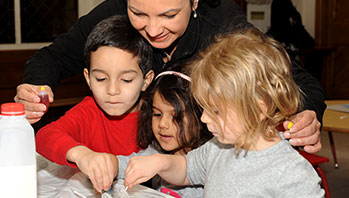- camera (optional)
- crayons
- magnifying lenses
- paper
- string
- branch
- plant
- root
- trunk
MA Standards:
Language/L.PK.MA.6: Use words and phrases acquired through conversations, listening to books read aloud, activities, and play.
Head Start Outcomes:
Logic and Reasoning/Reasoning and Problem Solving: Classifies, compares, and contrasts objects, events, and experiences.
Science Knowledge/Scientific Skills and Method: Uses senses and tools, including technology, to gather information, investigate materials, and observe processes and relationships.
Science Knowledge/Scientific Skills and Method: Observes and discusses common properties, differences, and comparisons among objects.
PreK Learning Guidelines:
English Language Arts/Language 2: Participate actively in discussions, listen to the ideas of others, and ask and answer relevant questions.
Small Group: Explore Trees

© Commonwealth of Massachusetts, Department of Early Education and Care (Jennifer Waddell photographer). All rights reserved.
STEM Key Concepts: A tree is a large plant; Trees, like all plants and living things, have parts that help them survive; Plants grow in places where they get their needs met; Plants often grow in some type of dirt
ELA Focus Skills: Compare and Contrast, Follow Directions, Speaking and Listening, Vocabulary
Safety Tips:
- Be aware of and check areas for poison ivy, poison sumac, nettles and bushes with thorns before taking children outside.
- Remind children to wash their hands before and after the activity.
- Remind children not to eat ANY plants or touch any plants without asking an adult.
- Take children’s allergies into account before going outside
Tell children that today you are going to take them outside again to observe some of the trees around the school. Tell them they will look at and feel the bark, measure the trunks, look at the leaves, etc. Take children outside and choose several trees to explore and compare.
- Explain that trees are very big plants. Point to the trees you have chosen and explain to children that they will explore and compare the trees.
- First, ask them to describe the trees you have pointed out. What do they notice about the sizes and shapes of the trees?
- Next, use string to measure around the trunk of each tree. Ask children, Which tree trunk is the biggest? Which tree trunk is the smallest?
- Then tell children to look closely at the branches and leaves or needles. Have children describe how they are similar or different.
- Invite them to look for and find the roots of the tree.
Reflect and Share
Ask questions such as,
- How are these trees like the little plants we have observed? How are they different?
- Where are the roots? How are the roots of the trees the same as/different from the roots of smaller plants?
- How do you think the tree roots help the tree?
Educator Tip: In coming weeks, some of the trees might go through changes. For example, there may be new leaves, flowers, or cones, or the leaves may change color or fall off. If so, have children observe the changes. Take photos so you have a record of the differences.
